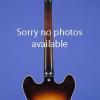Jazz -- Real Jazz, Swing Jazz
Weighs 6.20 lbs. and has a nut width of 1 11/16 inches and a standard Gibson scale length of 24 3/4 inches. Laminated curly maple top, back, and sides, mahogany neck, and rosewood fretboard with 20 jumbo frets and inlaid pearl split-parallelogram position markers. Headstock with decal "Gibson" logo. Individual Grover Roto-Matic tuners with tulip-shaped metal buttons. One Gibson '57 Classic humbucking pickup with an output of 7.49k. Bevelled five-layer (black/white/black/white/black) plastic pickguard. Two controls (one volume, one tone) on lower treble bout. Gold plastic barrel-shaped "Barrel" knobs. ABR-1 Tune-O-Matic retainer bridge on rosewood base and Old Style 175 tailpiece. All hardware gold-plated. Serial number ("91987485") on the back of the headstock and on a cream-colored oval label inside the bass f-hole. This guitar is in mint (9.50) condition. Housed in the original Gibson brown hardshell with purple plush lining (9.50).
"For jazz -- real jazz, swing jazz -- the kind that the legendary Herb Ellis plays, you only need one guitar. And, if you ask Herb, you only need one pickup. 'That's all you need,' confirmed the artist whose signature is on the Gibson ES-165 Herb Ellis. 'Otherwise, it gets into something that's not jazz.' When Gibson came to Herb in 1991 to design a signature jazz guitar, Herb specified a single humbucker on the ES-165 Herb Ellis. Not surprisingly, the HE signature model looks a lot like Herb's personal guitar -- a single-pickup ES-175, but with gold-plated hardware. Herb bought his ES-175 new in 1953 shortly after he joined the legendary Oscar Peterson Trio. Born in Farmersville, Texas, he had cut his teeth on the pioneering electric jazz guitar work of Charlie Christian. After a few years at North Texas State (majoring in bass because there was no guitar major available), he moved to Kansas City in 1944. Through his years with the Casa Loma Orchestra, the Jimmy Dorsey Orchestra and his own group, Soft Winds, he played a blonde Epiphone that he later sold to Howard Roberts. In 1953, Herb went to Eddie Bell at the New York Band Instrument Co., the Gibson dealer in Manhattan, and picked out an ES-175 -- not the new double-pickup model that debuted that year, but the standard single-pickup guitar that Gibson had introduced in 1949. Like all Gibson electrics at that time, it had a single-coil P-90 pickup with the black 'dog-eared' pickup cover. When Gibson introduced the humbucking pickup in 1957, Herb replaced his P-90 with one. 'The humbucker just got a clearer sound, and it was more balanced,' he recalled. Thirty-four years later, that same pickup still delivered the sound Herb wanted, and Gibson matched that sound for the ES-165 Herb Ellis model with a 490R humbucker. There's one feature on Herb's ES-175 you won't find on the ES-165 -- the string damper (made by guitarist George Van Eps). 'I've got it on my 165,' Herb said, 'but that guitar doesn't feed back, so I don't use it.' Even though the ES-165 Herb Ellis has only one pickup, a player still needs to make some adjustments to produce a great tone in every setting. Herb's secret is to always leave his amp on the same setting and then adjust the volume and tone on the guitar to fit the room...In addition to his solo performances, Herb and his ES-165 have been touring for the last five or six years with a reunited Oscar Peterson Trio, with Ray Brown on bass (and the addition of a drummer). As he has for over 50 years, he remains true to the traditional swing jazz style he helped establish in the late '40s and early '50s. Asked to elaborate on what is 'not jazz,' he had a ready answer: 'What is it they they call it? Fusion?' he explained. 'It's fusing something that can't be fused. You play the straight eighth notes over rock and roll. Jazz is dotted eights [a swing beat]'" (Walter Carter, "Gibson ES-165 Herb Ellis," at http://www.gibson.com/magazines/amplifier/1997/9/ax.html).
Translate:

